Educational Leadership Assignment - Part II Questions Analysis
VerifiedAdded on 2022/08/12
|6
|1327
|17
Homework Assignment
AI Summary
This assignment delves into key aspects of educational leadership, addressing crucial topics for effective management. It begins by defining and exploring the "Encourage the Heart" leadership behavior, highlighting its positive impact on organizational culture and employee relations. The assignment then examines strategies for managing and maintaining organizational structure, emphasizing the leader's role in strategic planning and mediation. It also outlines practical approaches to conflict management within teams, stressing the importance of immediate action, active listening, and communication. Furthermore, the assignment provides insights into motivating idle employees through appreciation, incentives, and addressing work-related problems. Finally, it details a step-by-step approach to presenting arguments as a leader, emphasizing active listening, clear articulation, and maintaining a respectful demeanor. The assignment draws on relevant academic sources to support its analysis and recommendations, offering a comprehensive overview of essential leadership principles.

Educational leadership
0 | P a g e
0 | P a g e
Paraphrase This Document
Need a fresh take? Get an instant paraphrase of this document with our AI Paraphraser
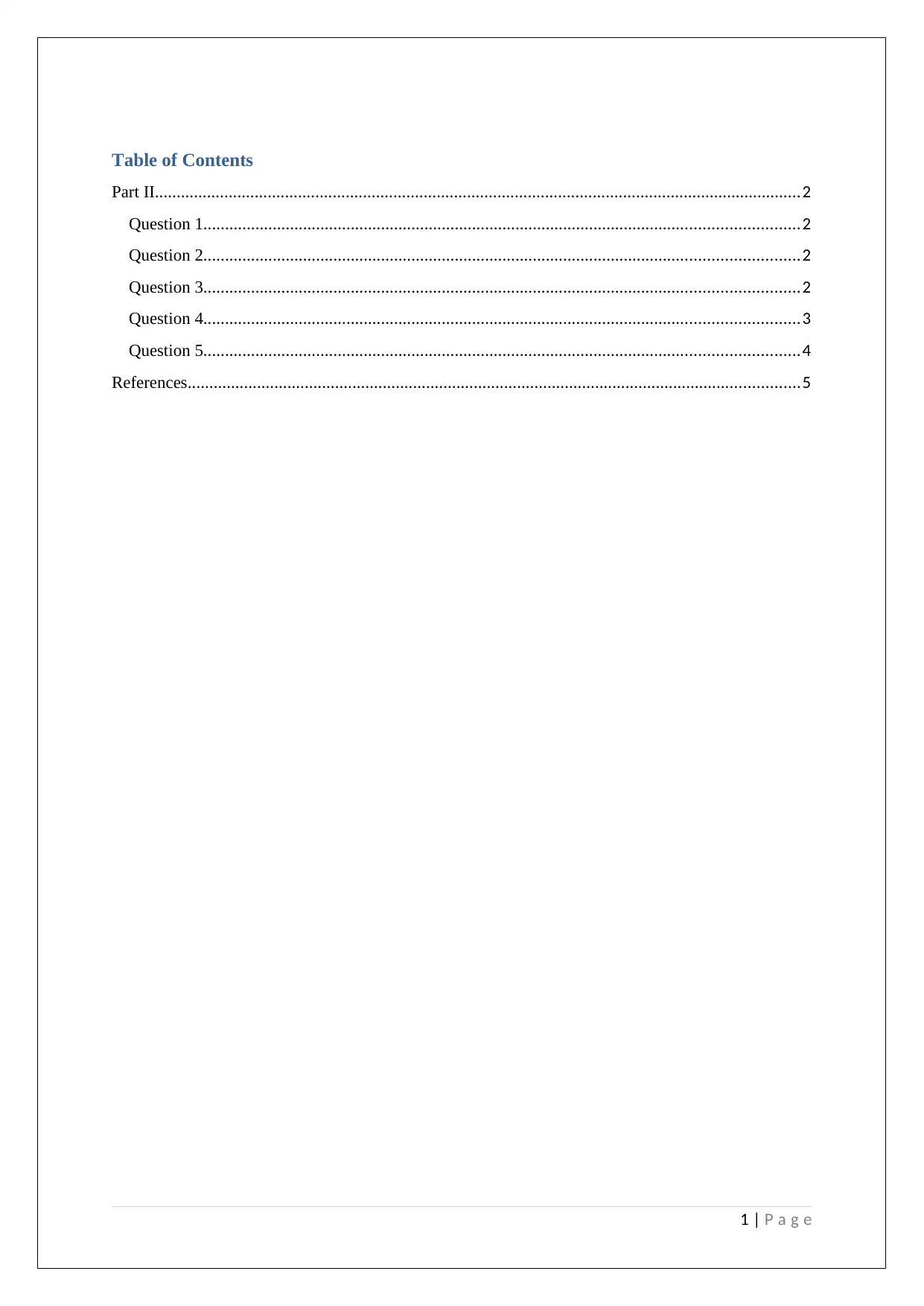
Table of Contents
Part II.....................................................................................................................................................2
Question 1.........................................................................................................................................2
Question 2.........................................................................................................................................2
Question 3.........................................................................................................................................2
Question 4.........................................................................................................................................3
Question 5.........................................................................................................................................4
References.............................................................................................................................................5
1 | P a g e
Part II.....................................................................................................................................................2
Question 1.........................................................................................................................................2
Question 2.........................................................................................................................................2
Question 3.........................................................................................................................................2
Question 4.........................................................................................................................................3
Question 5.........................................................................................................................................4
References.............................................................................................................................................5
1 | P a g e
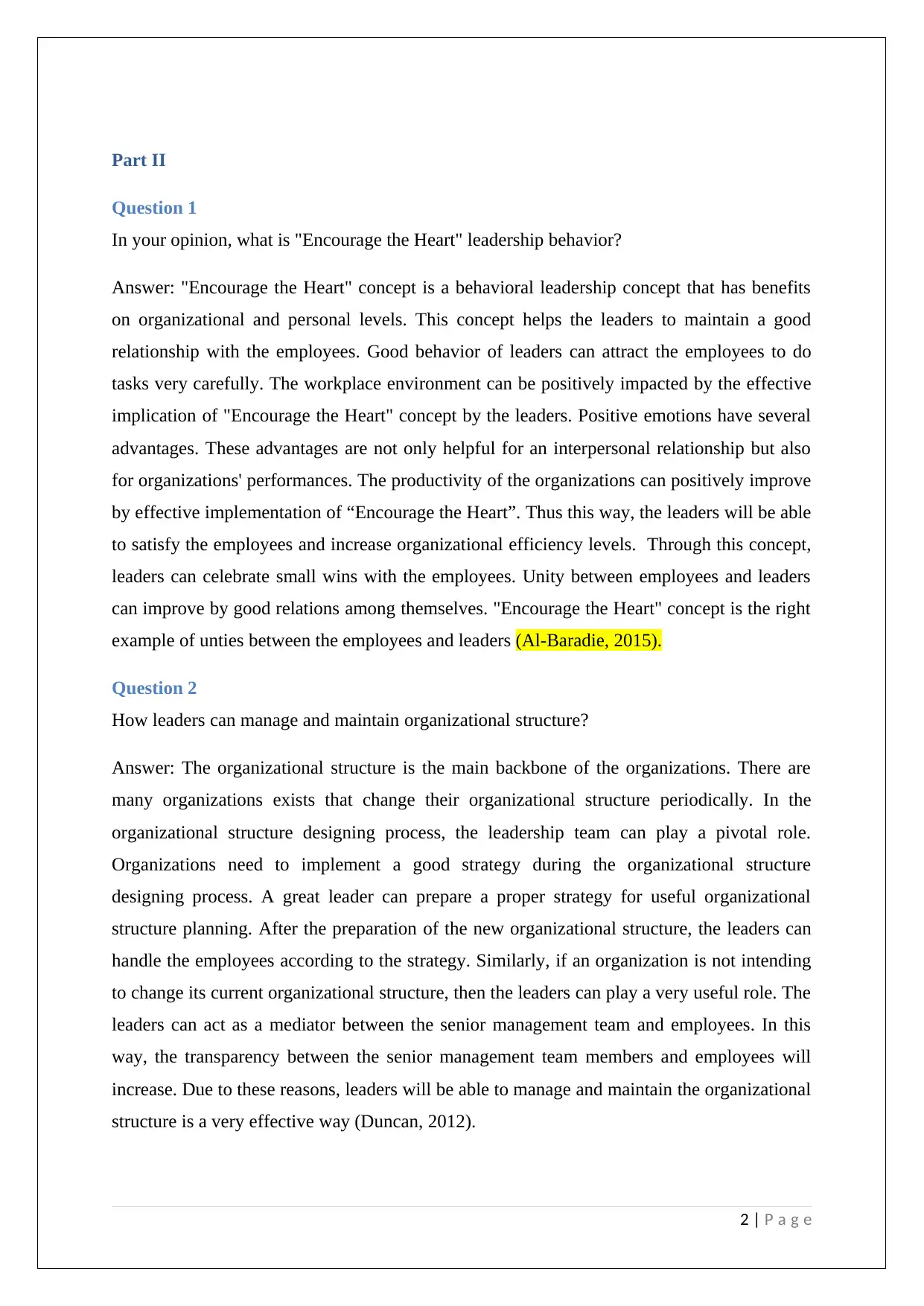
Part II
Question 1
In your opinion, what is "Encourage the Heart" leadership behavior?
Answer: "Encourage the Heart" concept is a behavioral leadership concept that has benefits
on organizational and personal levels. This concept helps the leaders to maintain a good
relationship with the employees. Good behavior of leaders can attract the employees to do
tasks very carefully. The workplace environment can be positively impacted by the effective
implication of "Encourage the Heart" concept by the leaders. Positive emotions have several
advantages. These advantages are not only helpful for an interpersonal relationship but also
for organizations' performances. The productivity of the organizations can positively improve
by effective implementation of “Encourage the Heart”. Thus this way, the leaders will be able
to satisfy the employees and increase organizational efficiency levels. Through this concept,
leaders can celebrate small wins with the employees. Unity between employees and leaders
can improve by good relations among themselves. "Encourage the Heart" concept is the right
example of unties between the employees and leaders (Al-Baradie, 2015).
Question 2
How leaders can manage and maintain organizational structure?
Answer: The organizational structure is the main backbone of the organizations. There are
many organizations exists that change their organizational structure periodically. In the
organizational structure designing process, the leadership team can play a pivotal role.
Organizations need to implement a good strategy during the organizational structure
designing process. A great leader can prepare a proper strategy for useful organizational
structure planning. After the preparation of the new organizational structure, the leaders can
handle the employees according to the strategy. Similarly, if an organization is not intending
to change its current organizational structure, then the leaders can play a very useful role. The
leaders can act as a mediator between the senior management team and employees. In this
way, the transparency between the senior management team members and employees will
increase. Due to these reasons, leaders will be able to manage and maintain the organizational
structure is a very effective way (Duncan, 2012).
2 | P a g e
Question 1
In your opinion, what is "Encourage the Heart" leadership behavior?
Answer: "Encourage the Heart" concept is a behavioral leadership concept that has benefits
on organizational and personal levels. This concept helps the leaders to maintain a good
relationship with the employees. Good behavior of leaders can attract the employees to do
tasks very carefully. The workplace environment can be positively impacted by the effective
implication of "Encourage the Heart" concept by the leaders. Positive emotions have several
advantages. These advantages are not only helpful for an interpersonal relationship but also
for organizations' performances. The productivity of the organizations can positively improve
by effective implementation of “Encourage the Heart”. Thus this way, the leaders will be able
to satisfy the employees and increase organizational efficiency levels. Through this concept,
leaders can celebrate small wins with the employees. Unity between employees and leaders
can improve by good relations among themselves. "Encourage the Heart" concept is the right
example of unties between the employees and leaders (Al-Baradie, 2015).
Question 2
How leaders can manage and maintain organizational structure?
Answer: The organizational structure is the main backbone of the organizations. There are
many organizations exists that change their organizational structure periodically. In the
organizational structure designing process, the leadership team can play a pivotal role.
Organizations need to implement a good strategy during the organizational structure
designing process. A great leader can prepare a proper strategy for useful organizational
structure planning. After the preparation of the new organizational structure, the leaders can
handle the employees according to the strategy. Similarly, if an organization is not intending
to change its current organizational structure, then the leaders can play a very useful role. The
leaders can act as a mediator between the senior management team and employees. In this
way, the transparency between the senior management team members and employees will
increase. Due to these reasons, leaders will be able to manage and maintain the organizational
structure is a very effective way (Duncan, 2012).
2 | P a g e
⊘ This is a preview!⊘
Do you want full access?
Subscribe today to unlock all pages.

Trusted by 1+ million students worldwide
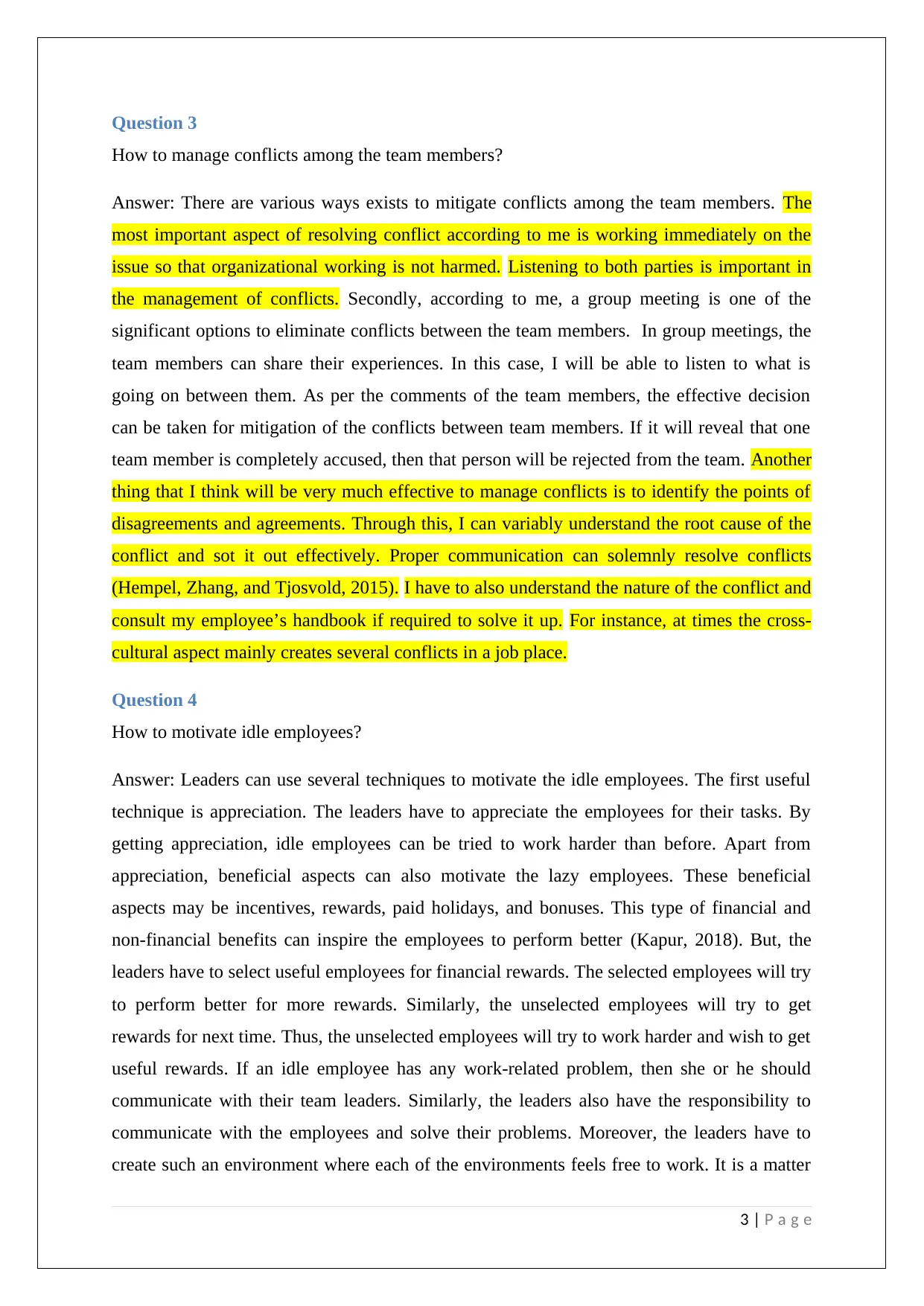
Question 3
How to manage conflicts among the team members?
Answer: There are various ways exists to mitigate conflicts among the team members. The
most important aspect of resolving conflict according to me is working immediately on the
issue so that organizational working is not harmed. Listening to both parties is important in
the management of conflicts. Secondly, according to me, a group meeting is one of the
significant options to eliminate conflicts between the team members. In group meetings, the
team members can share their experiences. In this case, I will be able to listen to what is
going on between them. As per the comments of the team members, the effective decision
can be taken for mitigation of the conflicts between team members. If it will reveal that one
team member is completely accused, then that person will be rejected from the team. Another
thing that I think will be very much effective to manage conflicts is to identify the points of
disagreements and agreements. Through this, I can variably understand the root cause of the
conflict and sot it out effectively. Proper communication can solemnly resolve conflicts
(Hempel, Zhang, and Tjosvold, 2015). I have to also understand the nature of the conflict and
consult my employee’s handbook if required to solve it up. For instance, at times the cross-
cultural aspect mainly creates several conflicts in a job place.
Question 4
How to motivate idle employees?
Answer: Leaders can use several techniques to motivate the idle employees. The first useful
technique is appreciation. The leaders have to appreciate the employees for their tasks. By
getting appreciation, idle employees can be tried to work harder than before. Apart from
appreciation, beneficial aspects can also motivate the lazy employees. These beneficial
aspects may be incentives, rewards, paid holidays, and bonuses. This type of financial and
non-financial benefits can inspire the employees to perform better (Kapur, 2018). But, the
leaders have to select useful employees for financial rewards. The selected employees will try
to perform better for more rewards. Similarly, the unselected employees will try to get
rewards for next time. Thus, the unselected employees will try to work harder and wish to get
useful rewards. If an idle employee has any work-related problem, then she or he should
communicate with their team leaders. Similarly, the leaders also have the responsibility to
communicate with the employees and solve their problems. Moreover, the leaders have to
create such an environment where each of the environments feels free to work. It is a matter
3 | P a g e
How to manage conflicts among the team members?
Answer: There are various ways exists to mitigate conflicts among the team members. The
most important aspect of resolving conflict according to me is working immediately on the
issue so that organizational working is not harmed. Listening to both parties is important in
the management of conflicts. Secondly, according to me, a group meeting is one of the
significant options to eliminate conflicts between the team members. In group meetings, the
team members can share their experiences. In this case, I will be able to listen to what is
going on between them. As per the comments of the team members, the effective decision
can be taken for mitigation of the conflicts between team members. If it will reveal that one
team member is completely accused, then that person will be rejected from the team. Another
thing that I think will be very much effective to manage conflicts is to identify the points of
disagreements and agreements. Through this, I can variably understand the root cause of the
conflict and sot it out effectively. Proper communication can solemnly resolve conflicts
(Hempel, Zhang, and Tjosvold, 2015). I have to also understand the nature of the conflict and
consult my employee’s handbook if required to solve it up. For instance, at times the cross-
cultural aspect mainly creates several conflicts in a job place.
Question 4
How to motivate idle employees?
Answer: Leaders can use several techniques to motivate the idle employees. The first useful
technique is appreciation. The leaders have to appreciate the employees for their tasks. By
getting appreciation, idle employees can be tried to work harder than before. Apart from
appreciation, beneficial aspects can also motivate the lazy employees. These beneficial
aspects may be incentives, rewards, paid holidays, and bonuses. This type of financial and
non-financial benefits can inspire the employees to perform better (Kapur, 2018). But, the
leaders have to select useful employees for financial rewards. The selected employees will try
to perform better for more rewards. Similarly, the unselected employees will try to get
rewards for next time. Thus, the unselected employees will try to work harder and wish to get
useful rewards. If an idle employee has any work-related problem, then she or he should
communicate with their team leaders. Similarly, the leaders also have the responsibility to
communicate with the employees and solve their problems. Moreover, the leaders have to
create such an environment where each of the environments feels free to work. It is a matter
3 | P a g e
Paraphrase This Document
Need a fresh take? Get an instant paraphrase of this document with our AI Paraphraser
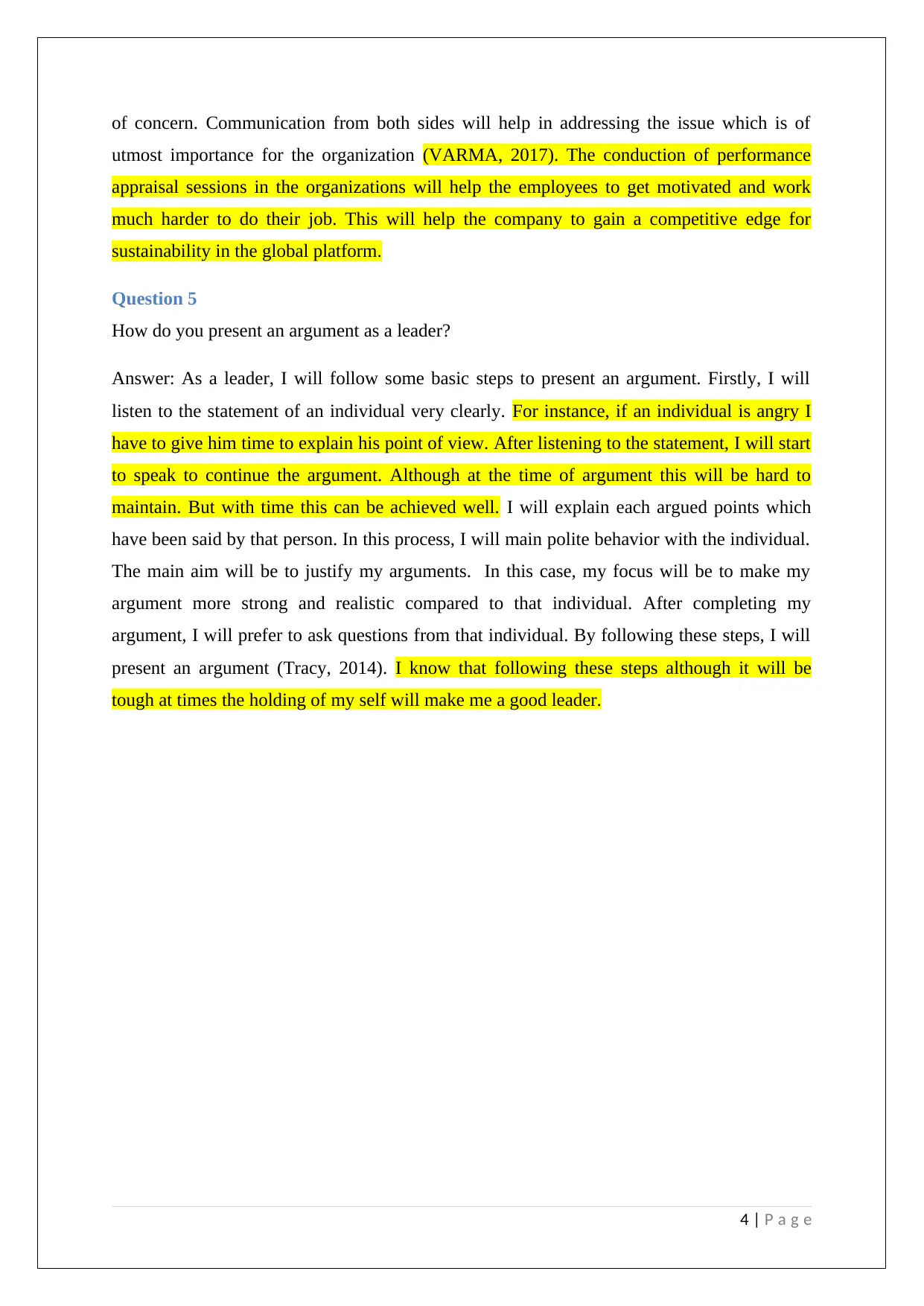
of concern. Communication from both sides will help in addressing the issue which is of
utmost importance for the organization (VARMA, 2017). The conduction of performance
appraisal sessions in the organizations will help the employees to get motivated and work
much harder to do their job. This will help the company to gain a competitive edge for
sustainability in the global platform.
Question 5
How do you present an argument as a leader?
Answer: As a leader, I will follow some basic steps to present an argument. Firstly, I will
listen to the statement of an individual very clearly. For instance, if an individual is angry I
have to give him time to explain his point of view. After listening to the statement, I will start
to speak to continue the argument. Although at the time of argument this will be hard to
maintain. But with time this can be achieved well. I will explain each argued points which
have been said by that person. In this process, I will main polite behavior with the individual.
The main aim will be to justify my arguments. In this case, my focus will be to make my
argument more strong and realistic compared to that individual. After completing my
argument, I will prefer to ask questions from that individual. By following these steps, I will
present an argument (Tracy, 2014). I know that following these steps although it will be
tough at times the holding of my self will make me a good leader.
4 | P a g e
utmost importance for the organization (VARMA, 2017). The conduction of performance
appraisal sessions in the organizations will help the employees to get motivated and work
much harder to do their job. This will help the company to gain a competitive edge for
sustainability in the global platform.
Question 5
How do you present an argument as a leader?
Answer: As a leader, I will follow some basic steps to present an argument. Firstly, I will
listen to the statement of an individual very clearly. For instance, if an individual is angry I
have to give him time to explain his point of view. After listening to the statement, I will start
to speak to continue the argument. Although at the time of argument this will be hard to
maintain. But with time this can be achieved well. I will explain each argued points which
have been said by that person. In this process, I will main polite behavior with the individual.
The main aim will be to justify my arguments. In this case, my focus will be to make my
argument more strong and realistic compared to that individual. After completing my
argument, I will prefer to ask questions from that individual. By following these steps, I will
present an argument (Tracy, 2014). I know that following these steps although it will be
tough at times the holding of my self will make me a good leader.
4 | P a g e
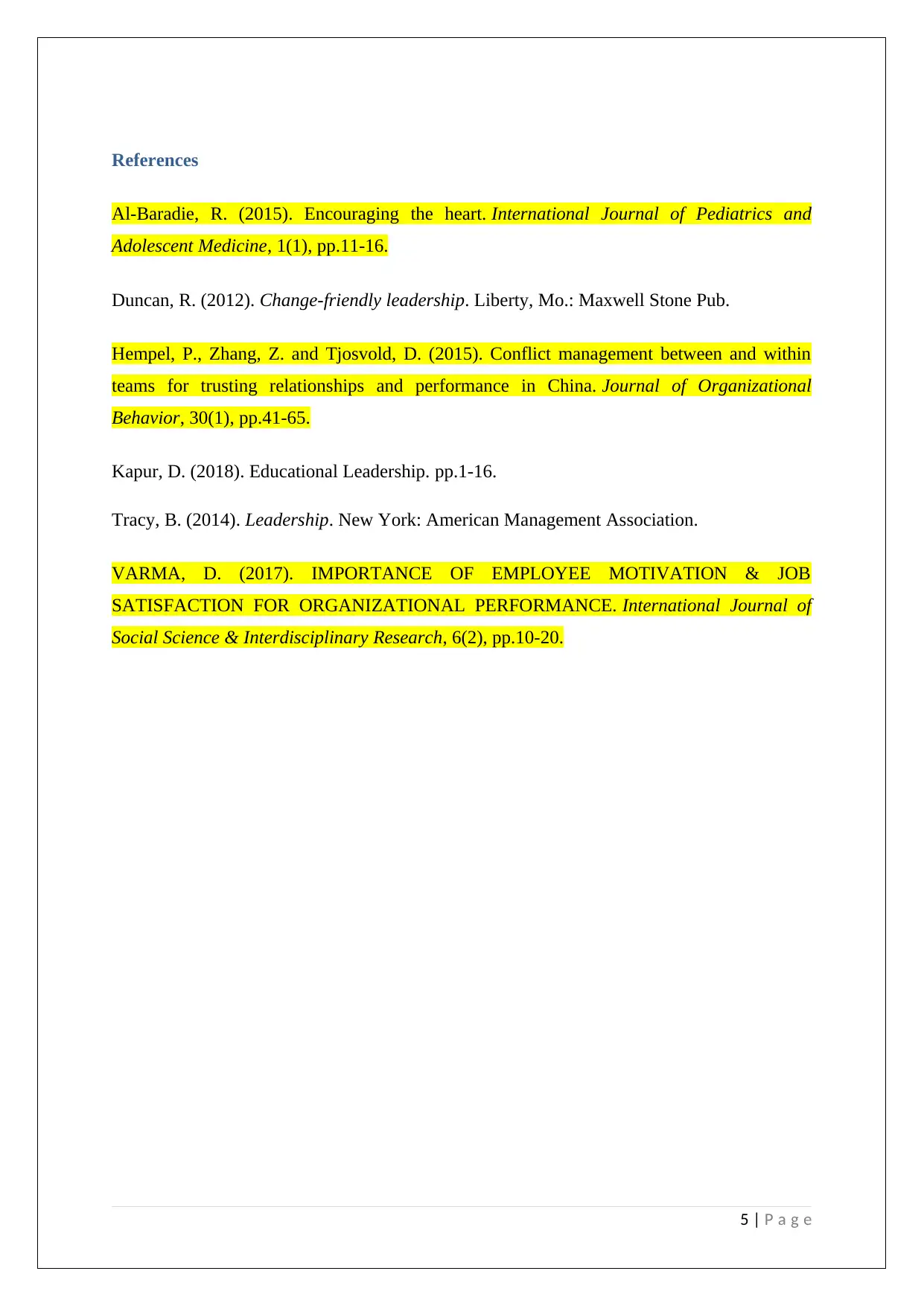
References
Al-Baradie, R. (2015). Encouraging the heart. International Journal of Pediatrics and
Adolescent Medicine, 1(1), pp.11-16.
Duncan, R. (2012). Change-friendly leadership. Liberty, Mo.: Maxwell Stone Pub.
Hempel, P., Zhang, Z. and Tjosvold, D. (2015). Conflict management between and within
teams for trusting relationships and performance in China. Journal of Organizational
Behavior, 30(1), pp.41-65.
Kapur, D. (2018). Educational Leadership. pp.1-16.
Tracy, B. (2014). Leadership. New York: American Management Association.
VARMA, D. (2017). IMPORTANCE OF EMPLOYEE MOTIVATION & JOB
SATISFACTION FOR ORGANIZATIONAL PERFORMANCE. International Journal of
Social Science & Interdisciplinary Research, 6(2), pp.10-20.
5 | P a g e
Al-Baradie, R. (2015). Encouraging the heart. International Journal of Pediatrics and
Adolescent Medicine, 1(1), pp.11-16.
Duncan, R. (2012). Change-friendly leadership. Liberty, Mo.: Maxwell Stone Pub.
Hempel, P., Zhang, Z. and Tjosvold, D. (2015). Conflict management between and within
teams for trusting relationships and performance in China. Journal of Organizational
Behavior, 30(1), pp.41-65.
Kapur, D. (2018). Educational Leadership. pp.1-16.
Tracy, B. (2014). Leadership. New York: American Management Association.
VARMA, D. (2017). IMPORTANCE OF EMPLOYEE MOTIVATION & JOB
SATISFACTION FOR ORGANIZATIONAL PERFORMANCE. International Journal of
Social Science & Interdisciplinary Research, 6(2), pp.10-20.
5 | P a g e
⊘ This is a preview!⊘
Do you want full access?
Subscribe today to unlock all pages.

Trusted by 1+ million students worldwide
1 out of 6
Related Documents
Your All-in-One AI-Powered Toolkit for Academic Success.
+13062052269
info@desklib.com
Available 24*7 on WhatsApp / Email
![[object Object]](/_next/static/media/star-bottom.7253800d.svg)
Unlock your academic potential
Copyright © 2020–2025 A2Z Services. All Rights Reserved. Developed and managed by ZUCOL.




